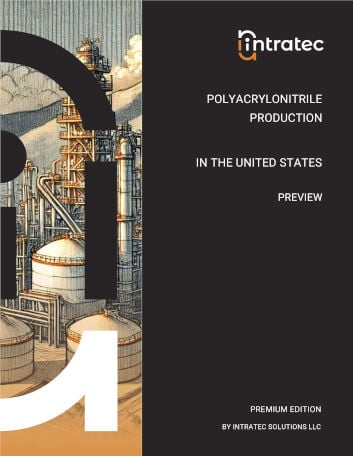Commodity Production Costs Report
Carbon Fiber Production from PAN Fiber
Carbon Fiber Plant Capital & Operating Cost Analysis | United States | Q3 2025
This report presents the economics of Carbon Fiber production from polyacrylonitrile (PAN) fiber. The process examined employs a conventional gas-phase oxidation for PAN stabilization, a carbonization-graphitization step, and a typical anodic oxidation for surface treatment. In this process, PAN fiber is initially stabilized. Subsequently, the stabilized PAN undergoes carbonization, graphitization, surface treatment, sizing, and winding, yielding the final Carbon Fiber product.
The report provides a comprehensive study of Carbon Fiber production and related Carbon Fiber production cost, covering three key aspects: a complete description of the Carbon Fiber production process examined; an in-depth analysis of the related Carbon Fiber plant capital cost (Capex); and an evaluation of the respective Carbon Fiber plant operating costs (Opex).
The Carbon Fiber production process description includes a block flow diagram (BFD), an overview of the industrial site installations, detailing both the process unit and the necessary infrastructure, process consumption figures and comprehensive process flow diagrams (PFD). The Carbon Fiber plant capital cost analysis breaks down the Capex by plant cost (i.e., ISBL, OSBL and Contingency); owner's cost; working capital; and costs incurred during industrial plant commissioning and start-up. The Carbon Fiber plant operating costs analysis covers operating expenses, including variable costs like raw materials and utilities, and fixed costs such as maintenance, labor, and depreciation.

The process under analysis comprises three major sections: (1) Stabilization; (2) Carbonization and graphitization; and (3) Surface treatment and sizing.
Stabilization. The PAN precursor fiber is oxidized into infusible thermosetting fibers through gas-phase oxidation at 230-250 °C. This stabilization (thermosetting) aims to prevent softening and resulting deformation of the pitch fibers upon heating downstream.
Carbonization and graphitization. After stabilization, the PAN fibers are carbonized in a multi-zone furnace, under an inert atmosphere, in successive heating zones with temperatures increasing from about 700 to about 1,700 °C. The carbonization’s goal is to remove elements other than carbon from the fibers and to grow graphite crystals (graphitization). The carbonized fibers are then heated to higher temperatures (2,500-3,000 °C) to promote the growth of the ordered structure, increase crystalline orientation in the fiber direction, and reduce the interlayer spacing (increasing carbon fiber’s tensile modulus of elasticity).
Surface treatment and sizing. The Carbon Fiber is submitted to anodic oxidation (electrolytic bath) to roughen the filament surface and introduce functional groups into the fiber surface (improving interfacial fiber/matrix bonding). The Carbon Fiber is then coated with a resin solution to protect it in downstream operations and keep filaments adhered together in individual tows. Finally, the Carbon Fiber is wound onto bobbins and stored.
Report in PDF Format
Download & Explore Anytime
Access in Various Devices
Print & Read Comfortably
Share With Co-workers
Up-to-date Report
Professional report based on Q3 2025 economic data, ensuring timely evaluations.
Multiple Use Cases
Ideal for investment screening, feasibility studies, cost estimates, and research planning.
Proven Methodology
Developed using a consistent methodology honed over a decade, ensuring reliable cost analyses.
Report Editions
Content Highlights
Plant Capital Cost Summary
Summary outlining the capital cost required for building the Carbon Fiber production plant examined.
Plant Capital Cost Details
Detailing of fixed capital (ISBL, OSBL & Owner’s Cost), working capital and additional capital requirements.
Plant Cost Breakdowns
Breakdown of Carbon Fiber process unit (ISBL) costs and infrastructure (OSBL) costs; plant cost breakdown per discipline.
Operating Costs Summary
Summary presenting the operating variable costs and the total operating cost of the Carbon Fiber production plant studied.
Operating Cost Details
Detailing of utilities costs, operating fixed costs and depreciation.
Plant Capacity Assessment
Comparative analysis of capital investment and operating costs for different Carbon Fiber plant capacities.
Production Process Information
Block Flow Diagram, descriptions of process unit (ISBL) and site infrastructure (OSBL).
Process Consumptions
Raw materials and utilities consumption figures, by-products credits, labor requirements
Process Diagrams
Process flow diagrams (PFD), equipment list and industrial site configuration
Other Carbon Fiber Production Cost Reports

Carbon Fiber Production from Pitch
This report presents a feasibility study of a process for Carbon Fiber production from petroleum pitch in the United States. The process starts with a preparation step that converts the pitch into mesophase pitch. The mesophase pitch is then stabilized and passes through carbonization, graphitization, surface treatment and sizing, before being wound.
Details: 1.5 kta United States-based plant | Q3 2025 | 107 pages | Issue B | From
Bundle & Save
Purchase multiple Carbon Fiber Production Cost reports and enjoy tiered discounts
up to 10% off!
Could Not Find the Report You Need?
Obtain a Bespoke Report
Get a report targeting the process in which you are interested
See Offer Details
Understand Bespoke Reports and how you can easily order them
Check Editions & Pricing
Complete a brief form and see a quotation for your Bespoke Report
Other Related Production Cost Reports

Polyacrylonitrile Production
This report presents a techno-economic analysis of Polyacrylonitrile (PAN) Precursor production in the United States via aqueous dispersion polymerization of acrylonitrile with methyl acrylate comonomer followed by transformation steps to become a fiber.
Details: 9 kta United States-based plant | Q3 2025 | 107 pages | Issue A | From
+800 Reports Developed, Targeting +250 Commodities
Vast Report Library
858 independent and up-to-date reports examining embryonic and established production processes.
Free Sample Reports
Quickly understand the structure and depth of content of our professional reports.

